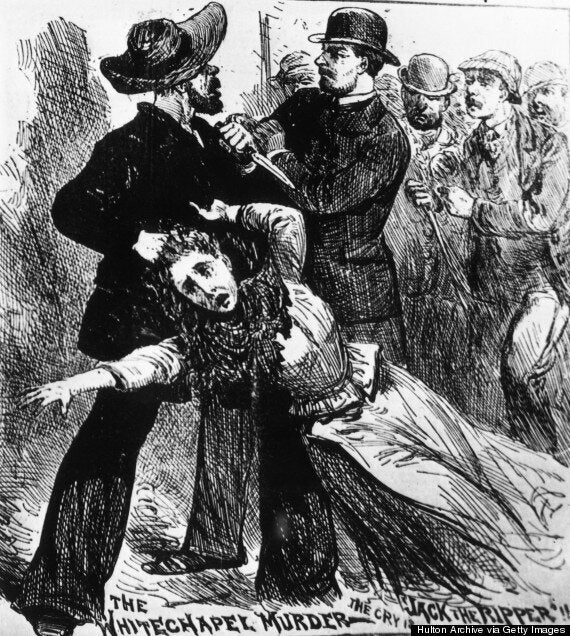Little is known about one of the most famous serial killers in history – and now even his sex is in doubt.
A shadowy figure who came to be known as Jack the Ripper was said to stalk the foggy alleyways of Whitechapel in 1888.
Five victims, all prostitutes were found murdered and mutilated, including Mary Kelly, the subject of a new book by William J Perring.

A fanciful engraving showing 'Jack The Ripper' being caught red-handed
The Seduction of Mary Kelly follows the life and times of the young woman believed to be the fifth and final victim of the Ripper.
It chronicles how the young woman came to be found mutilated virtually beyond recognition in a seedy, run down area of the East End.
Perring, who was born in east London theorises the killings were actually carried out by a female Salvation Army worker.
And he claims “Julia” the Ripper had a surprising motive in her work.
The 63-year-old told Huffington Post UK: "What if the killings... were in fact, carried out with the best of intentions? If this were the case, then every investigation and criminal profile would be rendered invalid, as it would be based on a total misunderstanding of the motive.

William J Perring is the author of The Seduction of Mary Kelly
"History abounds with cases where terrible acts have been performed for the (perceived at least) general good - and there is no doubt the sensationalism of the Ripper murders created a focus on Whitechapel, that resulted in much being done to improve this previously ignored part of London.
"As Mary says in the book, when one terrible night she sees a homeless man nursing his dead child in his arms as he shelters from the rain:
'Had she been the victim of some terrible accident or ghastly murder, people would have flocked to the site. They would have wept and beaten their breasts over the tragedy of this little girl. They would have shouted, demanding action, incensed by the outrage of her death. But she had merely died of the commonplace – of cold and of hunger – and those same people passed by with barely a thought – and so, to my utmost shame, did I.'
Suspects for the murderer have ranged from an itinerant Polish labourer to the eminent Victorian doctor Sir William Gull, and even the painter Walter Sickert.
Perring is sceptical of these subjects, claiming: “At the height of the panic over the Ripper murders, it is reported that men were often mobbed simply for carrying what might be taken for a doctors bag.
"Given such hysteria, if the Ripper were a man, he would take his life in his hands every time he ventured out on his murderous quests.
"But a woman? She could pass unhindered and unsuspected even in the midst of the greatest hue and cry – and if she were also a member of the salvation army, with her black uniform, so perfect for hiding bloodstains, then there would be even less chance of the least suspicion falling upon her. Indeed, she could easily pass policeman running to the scene of the latest murder.
"And if the murders were carried out for the ultimate greater good, then who more likely to conceive of the idea than someone not hardened from birth to the sights and sounds of Victorian Whitechapel, but who daily tried to ease the suffering of those who were?"
WARNING: The gallery below contains some graphic content
Perring is not the first to voice his suspicions the killer was a woman.
Author John Morris put his research forward in the book: Jack the Ripper: The Hand of A Woman.
In a well-argued case, Morris names the key suspect as Lizzie Williams, wife of Royal gynaecologist Sir John Williams - later considered a suspect himself. Trapped in an unhappy and childless marriage, Lizzie’s only route of escape was cut off when her family fortune was lost.
Dependent on her husband for wealth, reputation and security, Morris argues that Lizzie would have done anything to defend her marriage.
The story of Morris’s research includes many twists and turns as he examines the principle players, the killer’s motivation, and modern day cases that bear some similarity to the Ripper murders.
By the surgical nature of the wounds, the killer was assumed to have some surgical knowledge.
Morris's theory is supported by the findings of an Australian scientist who in 2006 used swabs from letters supposedly sent to police by the Ripper to build a partial DNA profile of the killer.
Ian Findlay, a professor of molecular and forensic diagnostics, told the Australian Broadcasting Corporation that he had developed a profiling technique that could extract DNA from a single cell or strand of hair up to 160 years old. Conventional DNA sampling methods require at least 200 cells.
Dr Findlay, who is based in Brisbane, travelled to London, where the evidence from the still-unsolved murders is stored at the National Archive.
The material, which was kept by Scotland Yard until 1961, includes letters sent to police at the time, some of them signed "Jack the Ripper". Most are believed to be fakes, but a handful are thought to have been written by the killer.
Dr Findlay took swabs from the back of stamps and from the gum used to seal envelopes, and possible bloodstains. He took his haul back to Brisbane, where - concentrating on swabs from the so-called "Openshaw letter", the one believed most likely to be genuine - he extracted the DNA and then amplified the information to create a profile.
The results were "inconclusive" and not forensically reliable, but he did construct a partial profile and based on this analysis, he said, "it's possible the Ripper could be female".

Author John Morris explores the theory the murderer was female
Last year a retired British murder squad detective put together what he claims is an image of Jack The Ripper.
Trevor Marriott created an e-fit of the man he believes was the responsible for the Ripper murders, a German merchant named Carl Feigenbaum, for a BBC television program.
Feigenbaum was a suspect at the time of the murders, and reportedly told his lawyer that he had a "desire to kill and mutilate every woman who falls in my way." He was later convicted of killing his landlady in Manhattan, and died in the electric chair in New York's Sing Sing prison.
No photographs of Feigenbaum exist, so the e-fit (an electronic artist's impression) was based on eyewitness descriptions.
There are hundreds of suspects who have been investigated by sleuths through the years, but no-one has ever been able to conclusively prove the killer's identity.
This is not the first time that experts have attempted to use modern policing techniques to identify the Ripper. In 2006, Scotland Yard experts created this e-fit of what they thought the Ripper would look like.